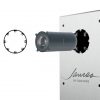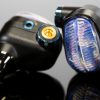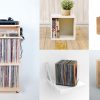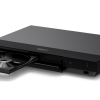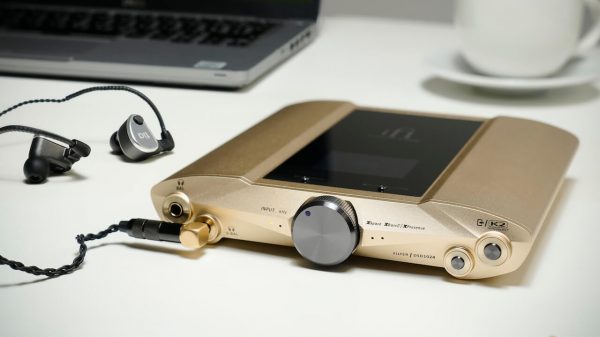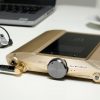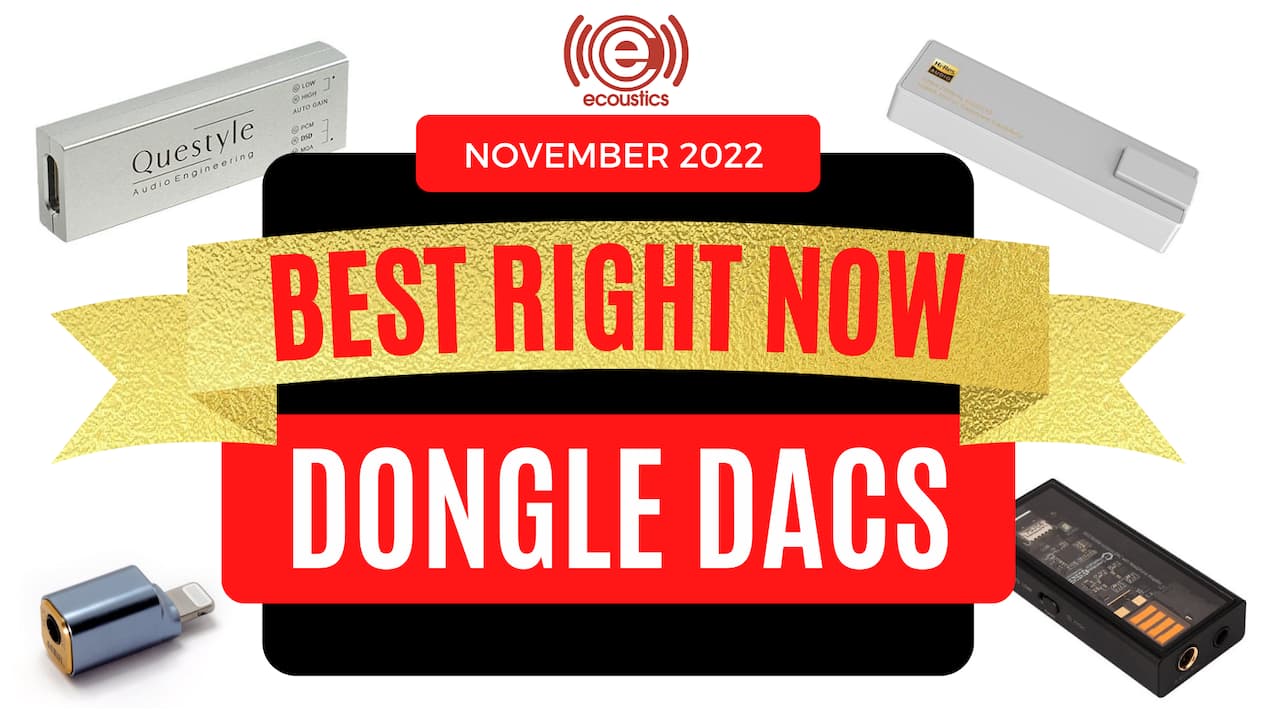It may be hard to believe, but iFi Audio have stayed out of the Dongle DAC frenzy over the past two years; their focus has been on the desktop side with the high-powered Diablo ($999) and Gryphon DAC/Headphone Amplifiers. They did introduce the iFi Go Blu DAC/Amplifier which certainly qualifies as a portable device but it is still on the larger side, requires recharging, and never really appealed to the USB or Lightning crowd looking for a true Dongle DAC. The iFi Go Bar Dongle DAC aims to change all of that.
iFi Audio is celebrating its tenth anniversary in 2022 and the British brand now offers more than 50 products in the portable, desktop, and accessories categories including a number of award-winning DACs, phono pre-amplifiers, and headphone amplifiers.

The iFi Go Bar is certainly not inexpensive at $329 USD and that makes it one of the most expensive in the category filled with some excellent options from Questyle, CEntrance, Cayin, and Apogee.
Can it compete or offer something that is truly unique in a saturated category where consumers are now increasingly unsure what to buy? iFi thinks the Go Bar is one of their best products yet and our experience with it would seem to suggest that they might be right.
The Skinny
iFi have never skimped when it comes to their products and the iFi Go Bar comes with everything you would need to get started; the package includes the Go Bar, USB Type-C to Type-C cable, Lightning to USB Type-C cable, and a small carrying case with a belt loop.
You do not need the Apple Camera Adapter if your iPhone still uses the Lightning connection and that was a really nice surprise to find that in the box.

The iFi Go Bar is 2.6″ x 0.9″ x 0.5″ and comes finished in a very sturdy and robust aluminum shell.
The nose includes 3.5mm and 4.4mm (balanced) headphone jacks which are nicely finished and provided firm connections with all of the plugs that I tried throughout the review.
The tail has a singe USB Type-C port for both charging and source device.

The left hand side of the chassis features a series of buttons for the volume control, tone controls, and the ability to engage the IEMatch.
The alloy case sports physical buttons for precise volume adjustment along with controls to select between various sonic tuning options. A column of coloured LEDs provides a handy guide to the format and sample rate of the digital audio currently playing, and whether XBass+ and/or XSpace are engaged.
The iFi Go Bar has two modes that allow users of sensitive IEMs or harder to drive full-sized headphones to use the Dongle DAC with either at the flick of a switch and I found that it was quite easy to use either.
The supplied manual is excellent and it took less than 5 minutes to learn all of the different button sequences to engage all of the settings and features; the iFi Go Bar is capable of driving a rather extensive range of IEMs and headphones and offers support for up to 32-bit/384kHz PCM, 2X DXD, DSD256, and full MQA decoding.

The DAC section of the Go Bar uses a powerful 16-core XMOS micro controller to process the audio data received at the USB input. The iFi team has programmed the XMOS firmware to optimize the sound quality and ensure a perfect partnership with the GO bar‘s 32-bit Cirrus Logic DAC chipset.
The GO bar’s analogue circuitry sports a balanced circuit design with a symmetrical twin-channel output stage. This reduces noise and crosstalk in the signal path by fully separating the left and right channels.
This is usually found in larger and more expensive amplifiers like the Gryphon and some of IFi’s other desktop headphone amplifiers.

The circuitry is packed full of high quality discrete components from TDK and Panasonic and special attention has been paid to power supply filtering too, dramatically reducing signal noise introduced through the USB input.
The iFi Go Bar offers 475mW into 32 ohms and 7.5V into 600 ohms.
The iFi Go Bar and Gryphon also share a few functions in common and are both built around the custom iFi firmware. The volume controls in Windows bypass software volume adjustments and force the use of the controls on the Go Bar instead of simply mirroring the software volume that you find on most devices.
The overall build quality is excellent and the iFi Go Bar is built to their usual standards that promise robustness and reliability.

Sound
To get a better feel for the iFi Go Bar, I connected it to an Apple MacBook Pro, Windows laptop, iPhone 12, and a Samsung S21 to determine how it handled Windows, Android, Apple macOS, and iOS devices.
With xBass engaged, the Go Bar delivers a solid degree of punch with both definition and enough impact to make listeners take notice regardless of the type of IEMs or headphones being used.
The mid bass is well textured and transparent sounding with no excess energy or bleed into the upper bass or lower midrange. With the feature enabled, bass information is pushed mildly forward in the mix but it never becomes too much; those looking for even more low end response might be slightly disappointed but I think iFi made the right choice here.
Other manufacturers have sacrificed definition, detail, and speed to appease listeners who want to really feel the low end, but iFi have wisely decided to focus on quality versus quantity.
The midrange is very clean sounding with good detail and fast transients; the overall level of resolution is very high for a Dongle DAC and I found instruments and vocals in this region to be very well reproduced.
Male vocals have excellent weight note and texture and cut through the instrumentation very well; nobody could ever find male vocals to be chesty or veiled through the iFi Go Bar.
Rock guitar was reproduced with just enough energy and growl to remain engaging even if the recording was less than stellar; lesser quality DACs often sound too hard or strip away the decay and I heard none of that with the Go Bar.
Female vocals were almost identical to their make counterparts; transparent, textured, detailed, and certainly not devoid of color. Orchestral works had more than enough energy and the reproduction of strings was quite appealing; decay, tone, and detail were first rate at this price point.
The treble is where some Dongle DACs get into trouble but the iFi Go Bar was quite linear sounding in the top end; there was no excess energy or abrupt roll-off point and I found the sound to be quite detailed and very open with almost every headphone or IEM. The highs were well extended and airy; Snare rattle had a nice crisp edge and cymbals had more than enough energy and detail to keep me engaged.
The soundstage and imaging really depended on the headphones or IEMs on the other end of the cable. The Go Bar did nothing to exaggerate the width or depth, and I felt that the stereo separation and imaging were generally rock solid, but that also had more to do with the headphones or IEMs than the amplifier.
Turbo mode certainly delivered on its promise of more power for demanding IEMs and headphones, and I didn’t find that it added a noticeable amount of noise unless I really turned the volume up to levels that no sane person would enjoy listening to music at.
One thing that I did discover is the Turbo mode can make the iFi Go Bar rather warm to the touch if you listen for prolonged periods of time. The harder you drive it — the warmer it gets.

Conclusion
iFi took its time coming to the Dongle DAC party but the Go Bar delivers on almost every promise and it has become one of my favorite in the category along with the Apogee, Questyle, and CEntrance models.
The iFi Go Bar delivers power, reliability, support of almost every digital format, solid industrial design, and excellent sound quality. The price is certainly high but it is one of the best I have tried so far and I suspect a product that is going to make waves in the category considering the company behind it.
Where to buy: $329 at Amazon | Crutchfield | Audio46 | Amazon.co.uk | Amazon.ca



